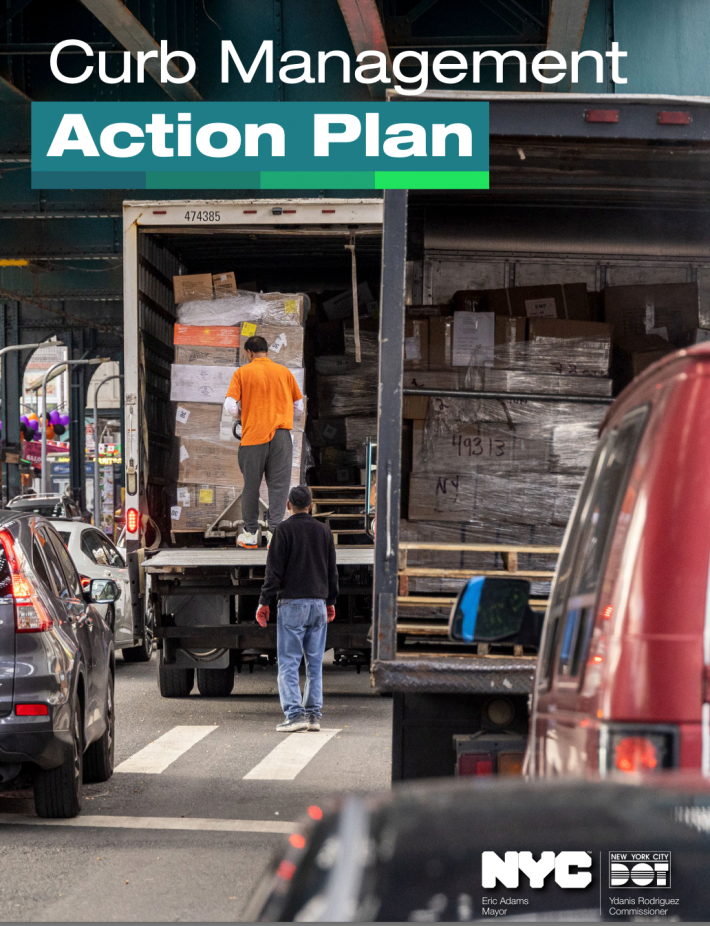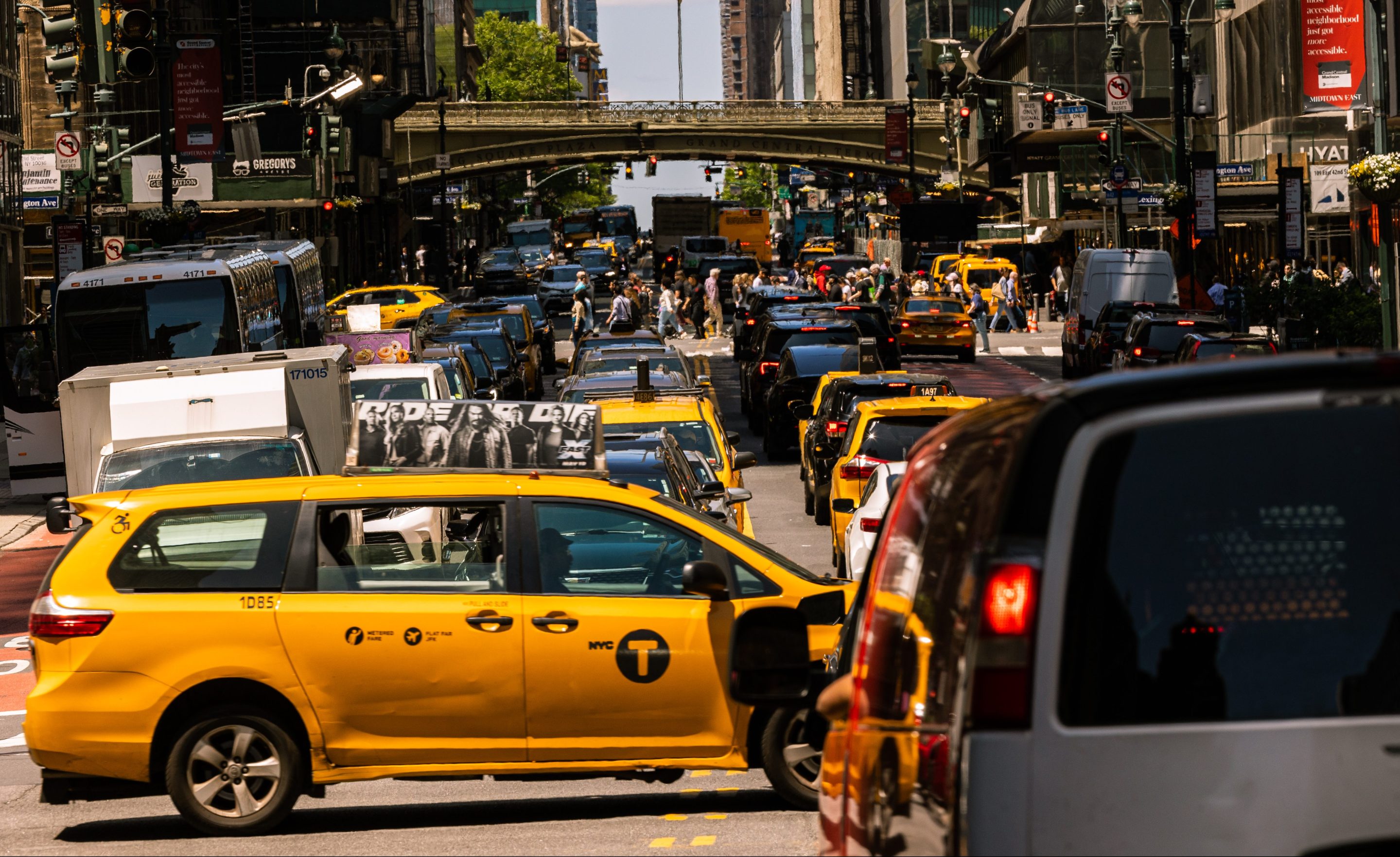Curb your curb enthusiasm.
The 80-percent pandemic-era surge in package deliveries has added more pressure to the competition for New York City's curbs — and the city Department of Transportation finally has a plan to deal with it ... eventually.

DOT and Mayor Adams on Tuesday released a 10-point curb management "action plan" full of plans to make plans to reorient curb space away from private car storage to more pressing uses like deliveries, taxi pick-up and drop-off, bike parking and more [PDF].
"Our administration is reimagining and better managing increasingly contested curbs to make our limited space work better for residents, businesses, and visitors," the mayor said in a statement, perhaps misusing the present tense given how much of the "action plan" is plan and not action.
Up first is a "Smart Curbs" pilot set to launch this year with the Columbus Avenue Business Improvement District on the Upper West Side of Manhattan. Officials say that the pilot will "reimagine curb space from scratch ... evaluate current curb regulations, identify community needs at the curb, and test new uses and technologies that make access easier."
To determine what each block needs at the curb, DOT plans to put together a "guide" that includes a yet-to-be-determined "curb management hierarchy" to be applied on a by-location basis, the agency said.
Among the potential "curb uses" DOT said it may explore in the "Smart Curbs" pilot:
- "microhubs" to serve as last-mile delivery distribution centers (which the city has mentioned previously).
- street furniture, plants, art and "pop-up markets," and delivery worker relief stations (which the city has mentioned previously).
- waste containers and bike parking (which the city has mentioned previously and previously, respectively).
Other items in Tuesday's announcement included plans to "examine" the implementation of low-emission zones ("re-examine" would be a better term, given that the city announced this back in April), and "pilot" technologies such as automated camera enforcement of parking regulations (which the city discussed back in 2021), and dynamic, demand-based pricing (which other cities have been doing for years). Officials also want to explore charging "non-transportation users" who operate in the curb lane, such as construction companies.
It's all good — but hardly revolutionary thinking on the part of the Adams administration. "Curb management," after all, have been buzzwords in the livable streets movement for years. And many of the "new" policies can be found in very old places: in a six-year-old National Association of City Transportation Officials report on curb management strategy or in economist Donald Shoup's groundbreaking book The High Cost of Free Parking, which is almost two decades old.
DOT itself acknowledged the need for a reevaluation of the curb in its pre-Covid 2019 "Mobility Report" which stated that, "Over the past 10 years, there has been a rise in the number of at-home deliveries, creating additional need for dedicated curb access." Before Covid, 45 percent of New Yorkers received at least on package at home each week — that number has increased.
On the plus side, activists and experts were pleased that the city, at long last, is acting.
“It sounds like the city’s finally listening to us," said Rachel Weinberger, research and strategy director at the Regional Plan Association, which offered curb recommendations in a 2021 report, "Re-envisioning the Right-of-Way."
"What the city is really saying is [that] to make our street system work better, we need to understand the whole system aspect of it, and [that] the curb lane is part of the system, and the user group they’re trying to accommodate is no longer just car drivers and truckers."
The agency's renderings released on Tuesday show that city officials understand how the curb should look — with almost no parking for private vehicles and ample curb space allocated to bike lanes, bike parking, delivery trucks, outdoor seating, flood-preventing greenery and quick pick-ups and drop-offs:

But so far DOT hasn't accomplished much more than tinkering around the edges, and the report fails to address the primary obstacle to more efficient and democratic use of the curb: the abundance of free parking in residential neighborhoods, which leaves no room for the UPS or Amazon delivery truck in residential areas, or the cab coming to take you to the airport.
That then leads to double-parking on otherwise quiet streets — blocking traffic, spewing emissions and snarling bus service.
“There’s a lot of nice words in there. I’m very skeptical than any of it is going to happen in the real world," warned Upper West Sider Howard Yaruss, who co-chaired the Manhattan Community Board 7 transportation committee for six years.
Yaruss dismissed the Columbus Avenue pilot as "small," and insufficient given his committee's many requests of the years for loading zones, bike lanes, daylighting and other street changes — most of which he said fell on deaf ears.
"It’s a very small pilot and I’d be shocked if it goes anywhere," Yaruss said. “It doesn’t change the community. There are plans to have these incredibly small isolated tests of different street improvements, but they’re incredibly modest plans.”
Advocates nevertheless welcomed DOT's belated commitment to start to plan for the reimagining of the curb — while pointing out the agency's unfinished businesses of building local support for the changes and actually getting them implemented. People (at least the minority of New Yorkers who own cars) love their free parking, so it will be important to, um, convince them otherwise.
"The results will be transformative for pedestrians, cyclists, bus riders, businesses, freight deliverers, and many more New Yorkers – if, and only if, local leaders support the work in every neighborhood," Open Plans Co-Executive Director Sara Lind said in a statement.
"Judging by the high demand for New York’s curbs, we know this space is incredibly valuable," she added.
"Everyone wants a piece of the curb, but only private drivers are given widespread, free access. This action plan will begin to square that value, and the needs of the rest of the city, with reality."
Given how much of the Adams administration "action plan" owes a debt to city mayors of the recent and distant past, it's an interesting footnote that the report opens by blaming Mayor William O'Dwyer — who served from 1946 to 1950 — for making the single greatest mistake that led to the curb chaos we have today.
"Mayor William O’Dwyer legalized overnight parking in Manhattan, which established the curb lane’s reputation as the place to store our personal vehicles — typically for free," the report says.
Here is a recent video about one activist group's effort to get the city to curb the chaos at the curb:






